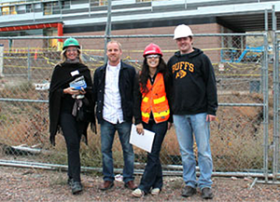Design-Build chapter seeks to connect students, professionals
Participating in a CAP student chapter of DBIA activity are, from left, Leila Tolderlund, Scott Rank, Maria Delgado and Bill Myhren.)
Just as the design-build system relies on collaboration between architects and builders, the university's student chapter of the Design Build Institute of America hinges on collaborations between students and professionals.
The new club within the College of Architecture and Planning has already worked with respected local firms such as Sprocket, RNL, Studio Completiva and Fransen and Pittman Construction to bring professionals into the classroom to discuss their approaches to design-build.
Maria Delgado, chapter president, said the idea is to connect students with leaders in the industry. The club currently has about 20 members and "it keeps growing," she said.
On Nov. 6, Delgado introduced John Pittman, principal of Fransen and Pittman Construction, and Yong Cho, principal of architectural firm Studio Completiva, to a lunch-hour meeting of the DBIA chapter. As they filled up on pizza, students were filled in on the advantages of design-build project delivery systems.
Cho and Pittman explained how their firms work together on architect-builder collaborations. The advantages of this approach include:
- Saves time
- Effort spent working toward the same goal
- Collaboration is rewarding
- Project success
Pittman explained that for a design-build collaboration to work, professionals need to check their egos at the door. Cho explained that the approach gives the project owners both resources -- the architect and the general contractors -- at the table together. "You can pull the best ideas from both of them, and there's also accountability because we're all working together," he said.
Patrick Beseda, the CAP chapter's vice president, said the chapter is an outgrowth of CAP's long-standing graduate certificate in design-build as an extension of the Master of Architecture program.
"We felt we needed a student organization that created awareness for design-build and was a way to get students involved in design-build while they're still in school," Beseda said.
Scott Rank, the club treasurer, said he'd been working professionally in design-build before enrolling in the Master of Architecture program at the University of Colorado Denver.
"The certificate program is kind of what interested me, and so this student organization of DBIA just seemed like a good way to connect that school experience to what's going on around us in professional firms," Rank said.
Rank, Delgado and Beseda, along with Phillip Gallegos, associate professor of architecture, traveled to Guatemala in Winterim 2012 to design a draft of a medical clinic and other facilities that the School of Medicine is establishing to improve the health of more than 3,000 banana plantation workers along with nearly 24,000 people in surrounding villages.
Delgado said goals of the DBIA student chapter are:
- Bringing in professionals to strengthen the connection between students and professionals.
- Offer tours of construction sites.
- Performing volunteer work.
On the latter goal, Delgado said, "We're actually working with (CAP) to do some sort of bench or planter -- some kind of small-scale project -- that gives back to the community."
The group is also volunteering on Habitat for Humanity projects.
"We really felt like having a club for students to learn more about design-build and actually being involved in different activities would enhance design-build in our school," she said.
CAP’s student chapter of the Design Build Institute of America (DBIA) was featured in the DBIA Rocky Mountain Region newsletter, October 2012 issue.
Visit their website at www.dbia-ucdenver.webs.com to learn more about the club. If a company is interested in participating with the club in any fashion it can reach DBIA at dbiaucdenver@gmail.com.


